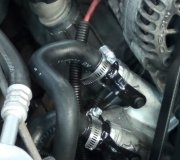The EVAP system is designed to reduce the amount of fuel vapor that is vented to the atmosphere. Fuel tank is vented through the charcoal canister, where vapor is stored, until it is purged into the intake manifold by the canister purge valve. The ECM or PCM controls the flow of fuel vapor by controlling the duty cycle of the canister purge valve.
Vehicle is equipped with one of 3 EVAP systems. On all systems, before the ECM or PCM allows canister purge operation, the following conditions must be met:
After battery disconnection, engine management adaptions must be reinstated.
Engine has run for at least 8 seconds.
Engine coolant temperature is 158 °F (70 °C) or more.
Engine is not running in the fuel cut-off condition.
Adaptive fuel correction function does not indicate a rich or lean failure.
EVAP system leak test has not failed.
No faults are detected in MAF sensor, ECT sensor, canister purge valve or canister close valve.
Single Canister System
This system uses a single charcoal canister with a pressure control valve between the canister and the fuel tank rollover valve. See Fig. 10. Pressure control valve is controlled by engine vacuum. When engine is off, pressure control valve is closed, maintaining a slight pressure in fuel tank. Any pressure increase causes the valve to open and release vapor to the canister. When engine is running, manifold vacuum holds the valve open. This maintains atmospheric pressure within the tank and allows vapor to flow to the canister.
Running Loss System
This system uses 2 charcoal canisters connected in series to reduce hydrocarbon emissions, and a normally open pressure control valve. See Fig. 11. A tank pressure sensor and canister close valve are used by the on-board diagnostic system to test for leaks in the system.
The pressure control valve allows continuous vapor flow to the canisters during normal running and prevents fuel from entering the vent line while refueling. Fuel tank vapor flows through the valve to the left canister. A third pipe connects the valve to the filler neck. When refueling, the difference in pressure between the tank and the filler neck closes the valve, preventing vapor flow. When the fuel filler cap is reinstalled, the pressure equalizes and allows the valve to open.
The canister close valve is a solenoid-operated valve controlled by the ECM. The valve is normally open and is closed only during the EVAP system leak test. The tank pressure sensor provides a signal to the ECM.
Running Loss With On-Board Refueling Vapor Recovery (ORVR) System
This system allows vapor generated during refueling to be collected by charcoal canisters. System uses 2 charcoal canisters connected in series to reduce hydrocarbon emissions. A tank pressure sensor and canister close valve are used by the on-board diagnostic system to test for leaks in the system. See Fig. 12. During normal running, vapor is collected and purged in the same manner as the Running Loss System.
The ORVR system has the following features:
A narrow fuel filler pipe providing a liquid seal when refueling, which prevents fuel vapor from venting to the atmosphere.
There is no vent between the tank and the filler pipe. A check valve at the lower end of the filler pipe is used to prevent fuel from surging up the filler pipe while refueling.
A Fuel Level Vent Valve (FLVV) consisting of a 2-stage shut-off valve with rollover protection and a pressure relief valve.
A grade vent valve with rollover protection and an outlet pipe connected to the FLVV outlet pipe.
Larger bore vapor pipes.
During refueling, the tank is vented through the FLVV, vapor hoses and charcoal canisters. The FLVV incorporates a float valve which is closed by the rising fuel level, creating a backpressure and causing refueling to stop. When the FLVV is closed (tank is full), any increase in pressure is relieved by the grade vent valve, by-passing the FLVV. When the FLVV is open, vapor vents to the canisters normally. The pressure relief valve allows vapor venting through the filler cap if a blockage or failure occurs.
Friday, March 12th, 2010 AT 1:49 PM


